Table of Contents
- Introduction
- Editor’s Choice
- EHR Market Statistics
- Methods Used by Hospitals to Electronically Find (Or Query) Patients’ Health Information
- Key EHR Vendors Statistics
- EHR Adoption Statistics
- Office-based Physicians with EMR/EHR Systems Industry Statistics
- Identify Patients for Care With Physician EHR Capability Statistics
- Impact of the EHR Industry on Patient Outcomes Statistics
- EHR Industry Statistics – By Region
- EHR Industry Interoperability and Health Information Exchange Statistics
- The EHR Industry Benefits
- Challenges in the EHR Industry Statistics
- Regulations for EHR Industry Statistics
- Recent Developments
- Conclusion
- FAQs
Introduction
EHR Industry Statistics: Electronic Health Records (EHRs) are digital versions of patient paper charts, revolutionizing healthcare by providing instant, secure access to comprehensive medical information.
They include details like medical history, diagnoses, medications, and test results, consolidating data from various sources into one accessible record.
EHRs enhance patient care by supporting better coordination among healthcare providers, improving efficiency through reduced paperwork, and enabling patient engagement via access to their records.
Challenges include high implementation costs, interoperability issues between different systems, and concerns about data privacy.
Looking ahead, advancements aim to improve interoperability, enhance data analytics, and integrate with telemedicine for more efficient and personalized healthcare delivery.
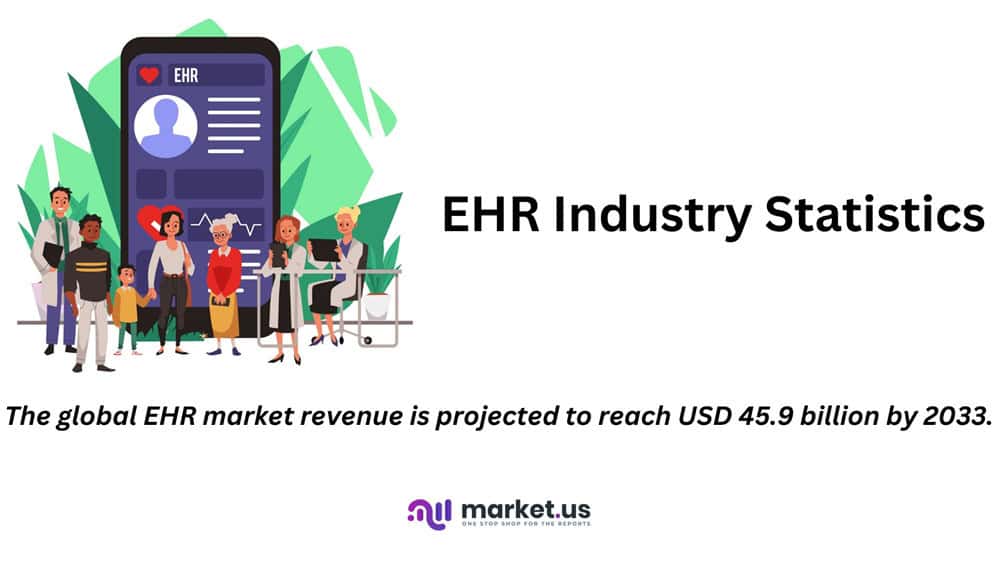
Editor’s Choice
- The global Electronic Health Records (EHR) market revenue reached $27.1 billion in 2023.
- By 2033, the market is anticipated to reach $45.9 billion, with cloud-based solutions contributing $21.11 billion and on-premise solutions $24.79 billion, reflecting a sustained and robust growth trajectory for both segments.
- The global Electronic Health Records (EHR) market is segmented by type into inpatient and outpatient EHR systems. In this market, inpatient EHR systems hold a dominant share, accounting for 55% of the market.
- As of the latest data, Epic Systems Corporation holds the largest market share among EHR vendors in the United States, commanding 28.21% of the market.
- The implementation of Electronic Health Records (EHR) has significantly improved various patient outcomes. Access to critical information has seen the most substantial enhancement, with an 80% improvement, facilitating timely and informed decision-making in patient care.
- As of 2019, the adoption of electronic medical records (EMR) among primary care physicians varied across selected countries, with New Zealand achieving full adoption at 100%.
- The implementation of Electronic Health Records (EHR) in India faces several significant challenges. Security and privacy concerns are paramount, affecting 28% of the implementation efforts, and are closely tied to the issue of lack of interoperability, which also impacts 28% of the initiatives.
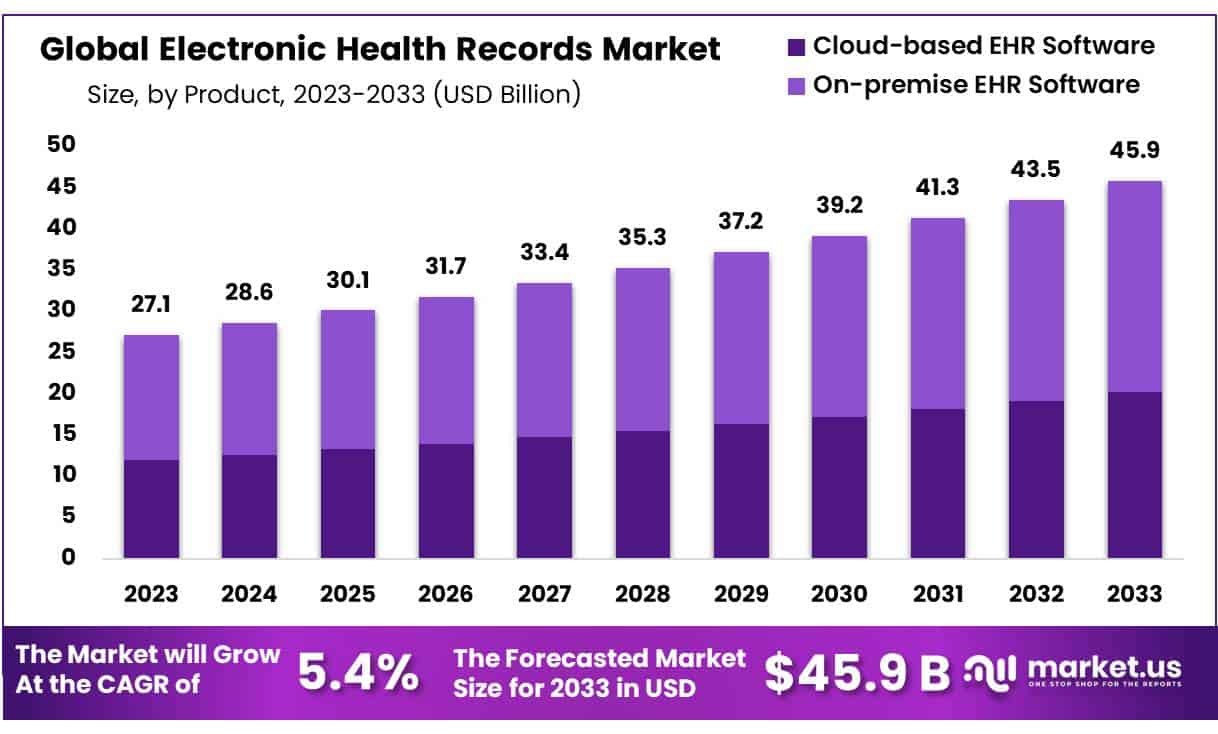
EHR Market Statistics
Global EHR Market Size Statistics
- The global Electronic Health Records (EHR) market has demonstrated consistent growth at a CAGR of 5.4%, with revenues reaching $27.1 billion in 2023.
- Projections indicate that this upward trajectory will continue. The market is expected to generate $28.6 billion in 2024 and $30.1 billion in 2025.
- By 2026, revenues are forecasted to rise to $31.7 billion, subsequently increasing to $33.4 billion in 2027.
- The market is anticipated to reach $35.3 billion in 2028 and $37.2 billion in 2029.
- By 2030, the EHR market revenue is projected to be $39.2 billion. With further growth expected, reaching $41.3 billion in 2031 and $43.5 billion in 2032.
- By 2033, the market is anticipated to achieve a revenue of $45.9 billion. Underscoring the sustained expansion and growing adoption of electronic health records globally.
(Source: market.us)
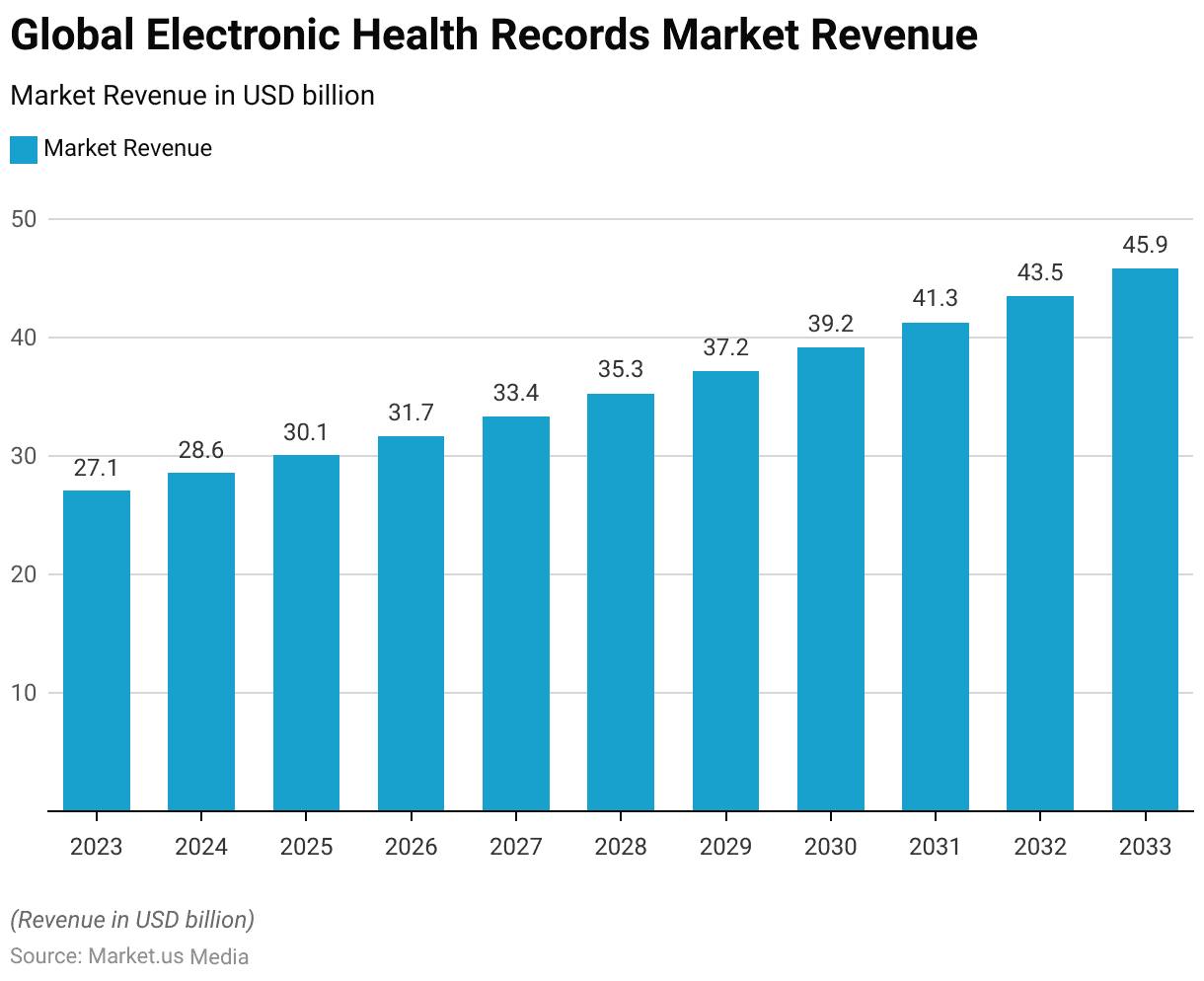
Global EHR Market Size – By Product Statistics
2023-2027
- The global Electronic Health Records (EHR) market, is segmented by product type. Showcases significant growth in both cloud-based and on-premise EHR software revenues.
- In 2023, the total market revenue was $27.1 billion. With cloud-based EHR software contributing $12.47 billion and on-premise EHR software generating $14.63 billion.
- This trend is expected to continue, with the total market revenue projected to reach $28.6 billion in 2024. With cloud-based and on-premise software revenues at $13.16 billion and $15.44 billion, respectively.
- By 2025, the market is anticipated to grow to $30.1 billion, with cloud-based solutions accounting for $13.85 billion and on-premise solutions for $16.25 billion.
- The revenue is expected to rise to $31.7 billion in 2026, with $14.58 billion from cloud-based and $17.12 billion from on-premise software.
- By 2027, the market is forecasted to reach $33.4 billion, with $15.36 billion from cloud-based and $18.04 billion from on-premise solutions.
2028-2033
- The upward trend continues with projected revenues of $35.3 billion in 2028, $37.2 billion in 2029, and $39.2 billion in 2030, with cloud-based solutions contributing $16.24 billion, $17.11 billion, and $18.03 billion, and on-premise solutions contributing $19.06 billion, $20.09 billion, and $21.17 billion, respectively.
- By 2031, the market is expected to grow to $41.3 billion, with $19.00 billion from cloud-based and $22.30 billion from on-premise software.
- In 2032, the total market is projected to be $43.5 billion, with cloud-based and on-premise revenues at $20.01 billion and $23.49 billion, respectively.
- By 2033, the market is anticipated to reach $45.9 billion, with cloud-based solutions contributing $21.11 billion and on-premise solutions $24.79 billion, reflecting a sustained and robust growth trajectory for both segments.
(Source: market.us)
Take advantage of our unbeatable offer - buy now!

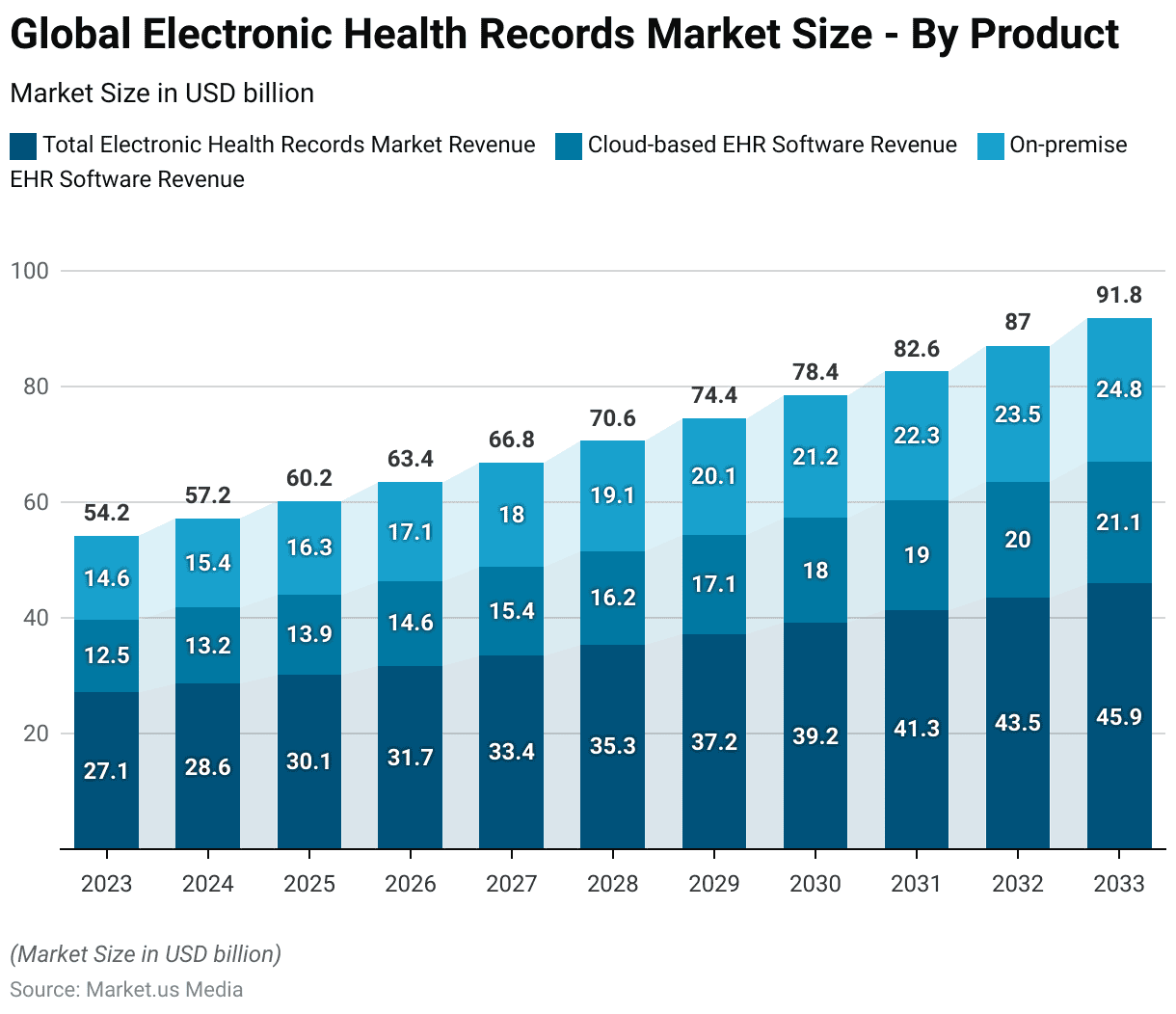
Global EHR Market Share – By Type Statistics
- The global Electronic Health Records (EHR) market is segmented by type into inpatient and outpatient EHR systems.
- In this market, inpatient EHR systems hold a dominant share, accounting for 55% of the market.
- Outpatient EHR systems, on the other hand, comprise the remaining 45% of the market share.
- This distribution underscores the significant reliance on inpatient EHR systems within healthcare facilities, while outpatient EHR systems also maintain a substantial presence, reflecting their crucial role in managing patient records in outpatient settings.
(Source: market.us)

Methods Used by Hospitals to Electronically Find (Or Query) Patients’ Health Information
- In 2021, hospitals employed various methods to find or query patients’ health information electronically.
- The most commonly used method was through state, regional, or local Health Information Exchanges (HIE), utilized by 61% of hospitals.
- Interface connections between Electronic Health Record (EHR) systems were used by 52% of hospitals, while 48% relied on national networks.
- EHR vendor-based networks were used by 46% of hospitals, and provider portals were utilized by 37%.
- Additionally, 30% of hospitals accessed other organizations’ EHR systems to retrieve patient health information.
- These methods highlight the diverse approaches hospitals take to ensure comprehensive and efficient access to patient health data.
(Source: ONC Data Brief)
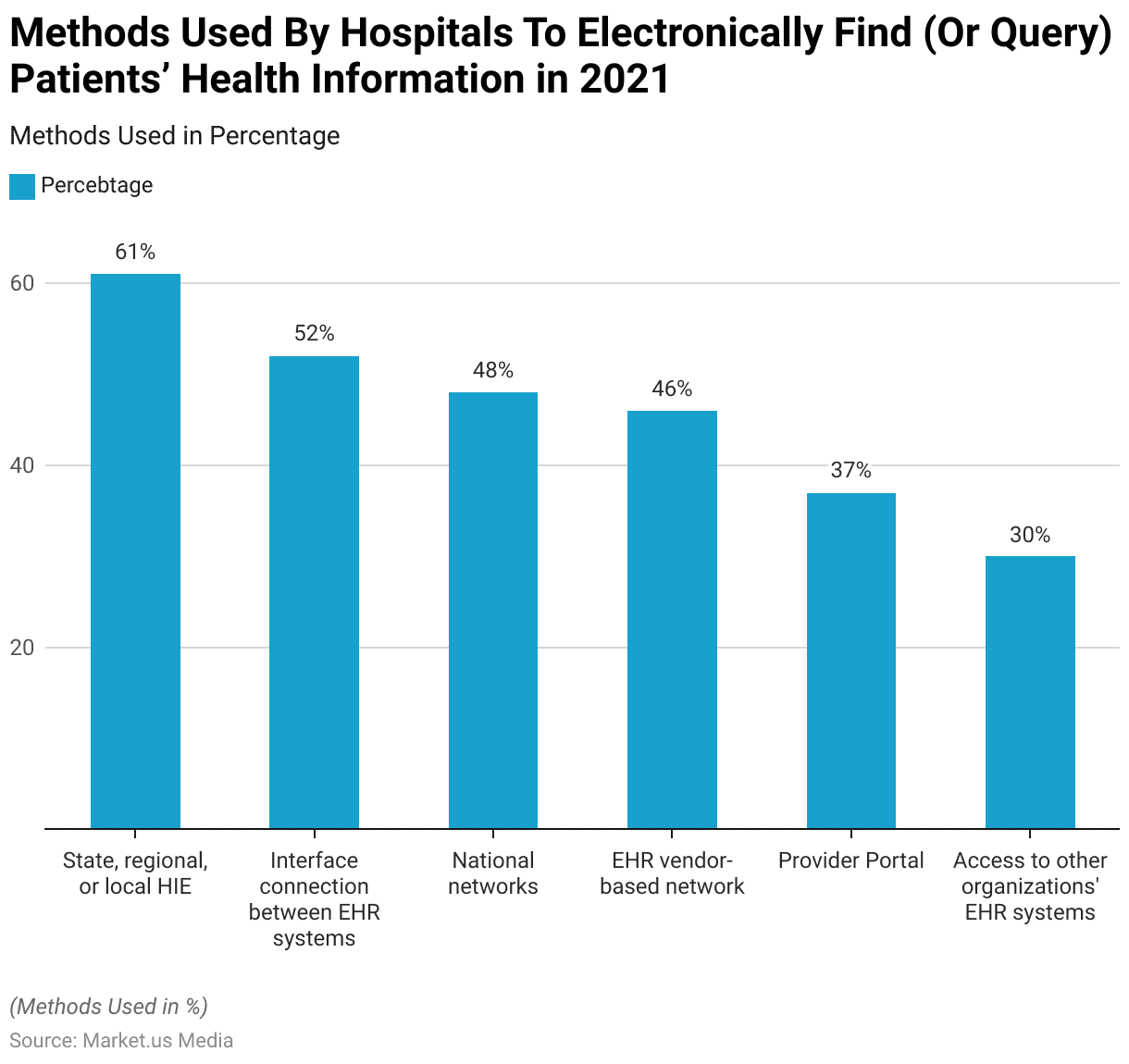
Key EHR Vendors Statistics
Top EHR Vendor’s/Industry Statistics
- As of the latest data, Epic Systems Corporation holds the largest market share among EHR vendors in the United States, commanding 28.21% of the market.
- Allscripts follows with a 9.21% share, while eClinicalWorks, LLC accounts for 6.57%.
- Athenahealth and NextGen Healthcare have market shares of 6.03% and 5.37%, respectively.
- GE Healthcare holds 5.00% of the market, and Cerner Corporation has a 4.32% share.
- Greenway Health, LLC follows with 2.91%.
- Other vendors with smaller market shares include eMDs at 1.12%, Modernizing Medicine, Inc. at 1.09%, and MEDENT-Community Computer Service, Inc. and Integrated Practice Solutions, Inc. each with 1.03%.
- Practice Fusion has a market share of 0.89%, Mckesson holds 0.86%, and SRS-Health has the smallest share at 0.72%.
- This distribution highlights Epic Systems Corporation’s dominant position in the EHR market, with a significant lead over other vendors.
(Source: Nix)
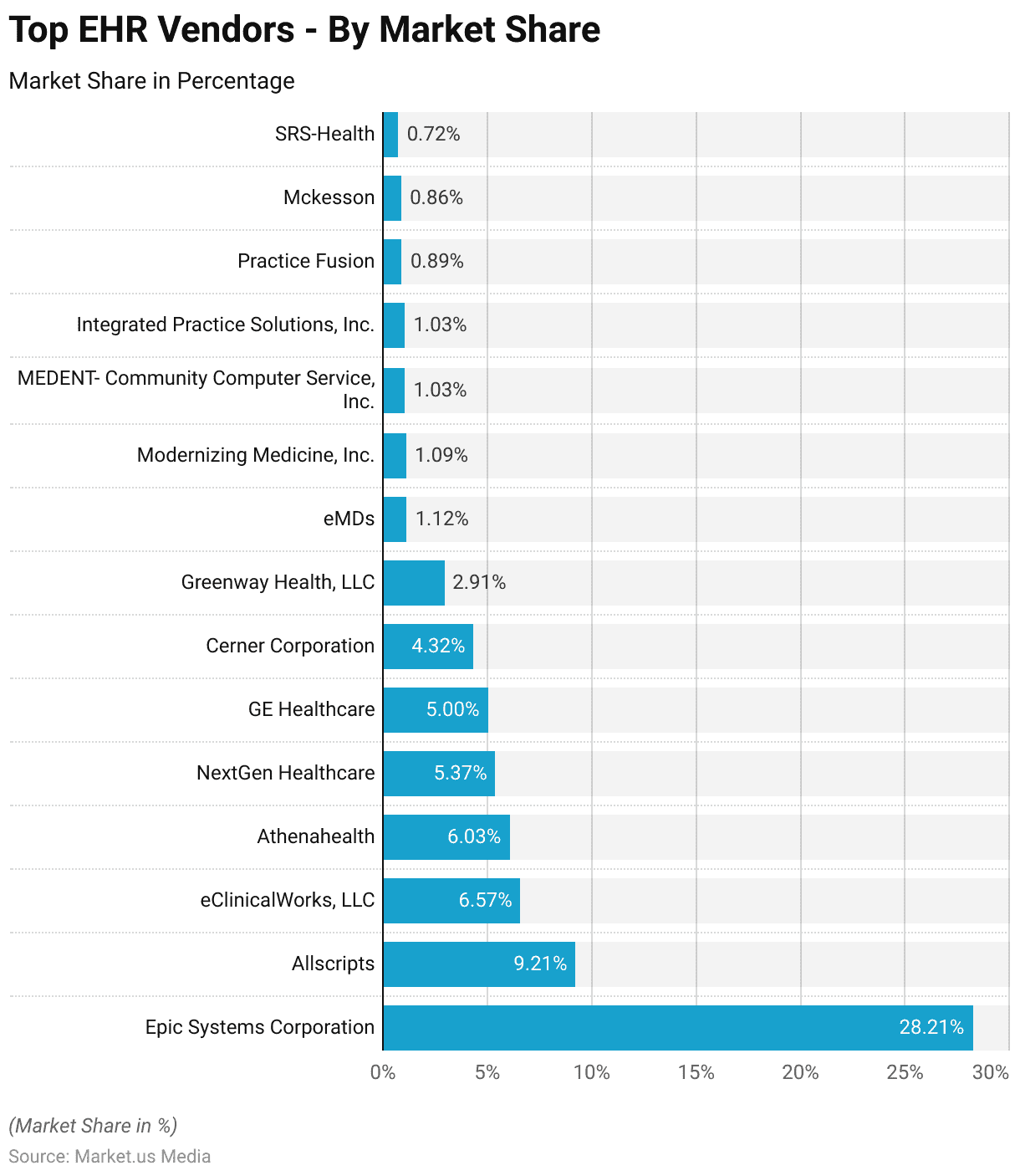
Ambulatory EHR Vendors/Industry Statistics
- As of May 2019, the market share of leading ambulatory EHR vendors in the United States was dominated by Epic, which held 33.4% of the market.
- Cerner followed with a significant share of 24.9%.
- MEDITECH accounted for 10.6% of the market, while Evident, a CPSI Company, held 7.9%.
- Allscripts captured 5% of the market, and Athenahealth held 3.2%.
- eClinicalWorks had a 3% market share, followed by Netsmart Technologies with 0.9% and NextGen Healthcare with 0.8%.
- The Indian Health Service had the smallest share among the leading vendors, accounting for 0.5% of the market.
- This distribution highlights the competitive landscape of the ambulatory EHR market in the United States, with a few vendors capturing the majority of the market share.
(Source: Statista)
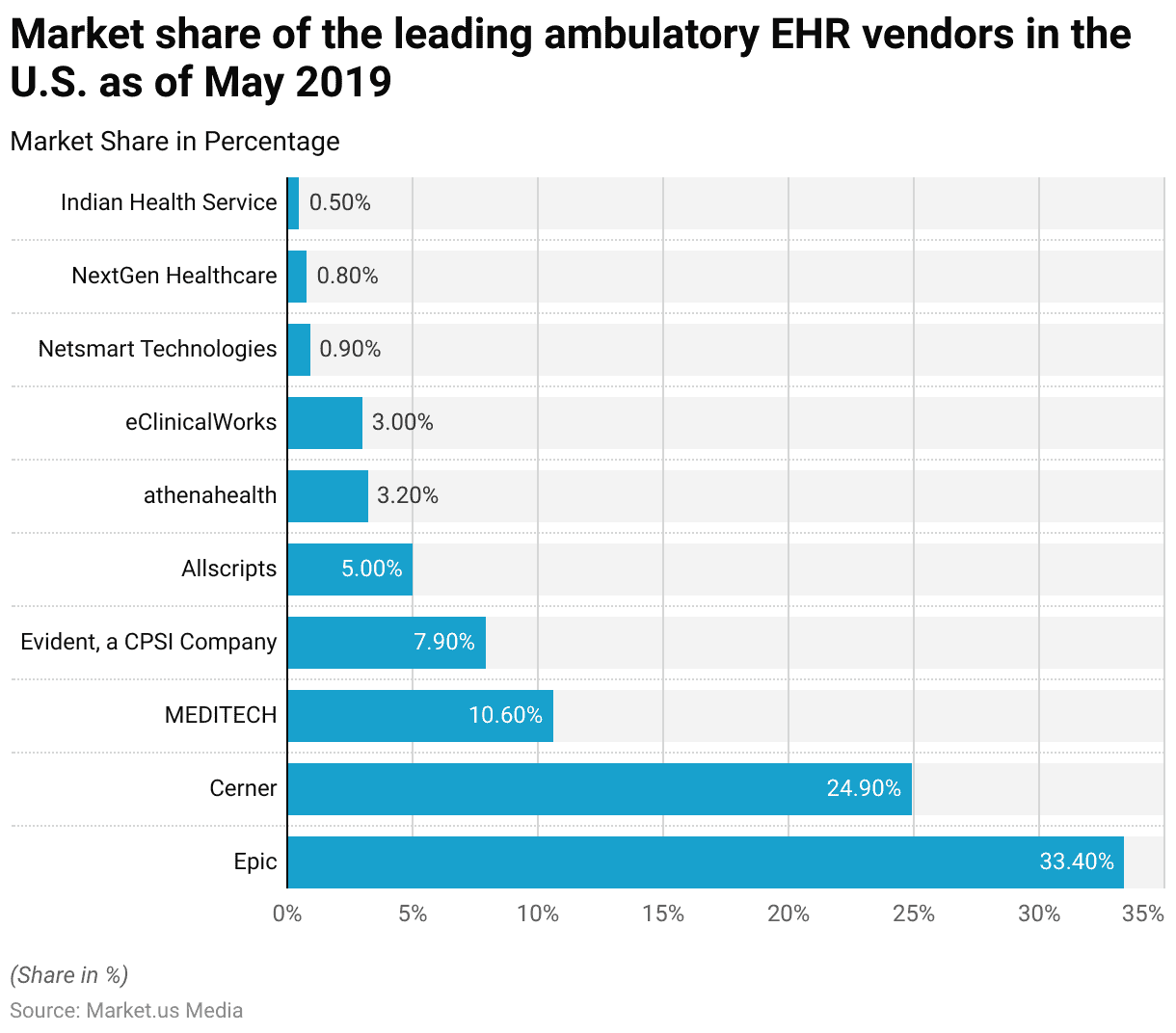
EHR Adoption Statistics
Adoption of EHR- By Hospital Service Type Industry Statistics
- The adoption of Electronic Health Records (EHR) varies by hospital service type, demonstrating high levels of integration across different categories.
- General acute care hospitals exhibit a substantial adoption rate, with 96% utilizing any form of EHR, 94% implementing Certified EHR Technology (CEHRT), and 86% using the 2015 edition of CEHRT.
- Psychiatric hospitals have 84% adoption of any EHR, 75% CEHRT adoption, and 67% utilization of the 2015 CEHRT.
- Specialty hospitals report lower adoption rates, with 75% using any EHR, 40% implementing CEHRT, and 23% adopting the 2015 CEHRT.
- Rehabilitation hospitals have 81% using any EHR, 63% implementing CEHRT, and 40% utilizing the 2015 CEHRT.
- Children’s hospitals demonstrate high adoption, with 97% using any EHR, 90% implementing CEHRT, and 86% using the 2015 CEHRT.
- Acute long-term care hospitals report 92% using any EHR, 88% implementing CEHRT, and 79% utilizing the 2015 CEHRT.
- These statistics reflect varying levels of EHR adoption across different hospital service types, with general acute care and children’s hospitals leading in EHR integration.
(Source: The Office of the National Coordinator for Health Information Technology (ONC))
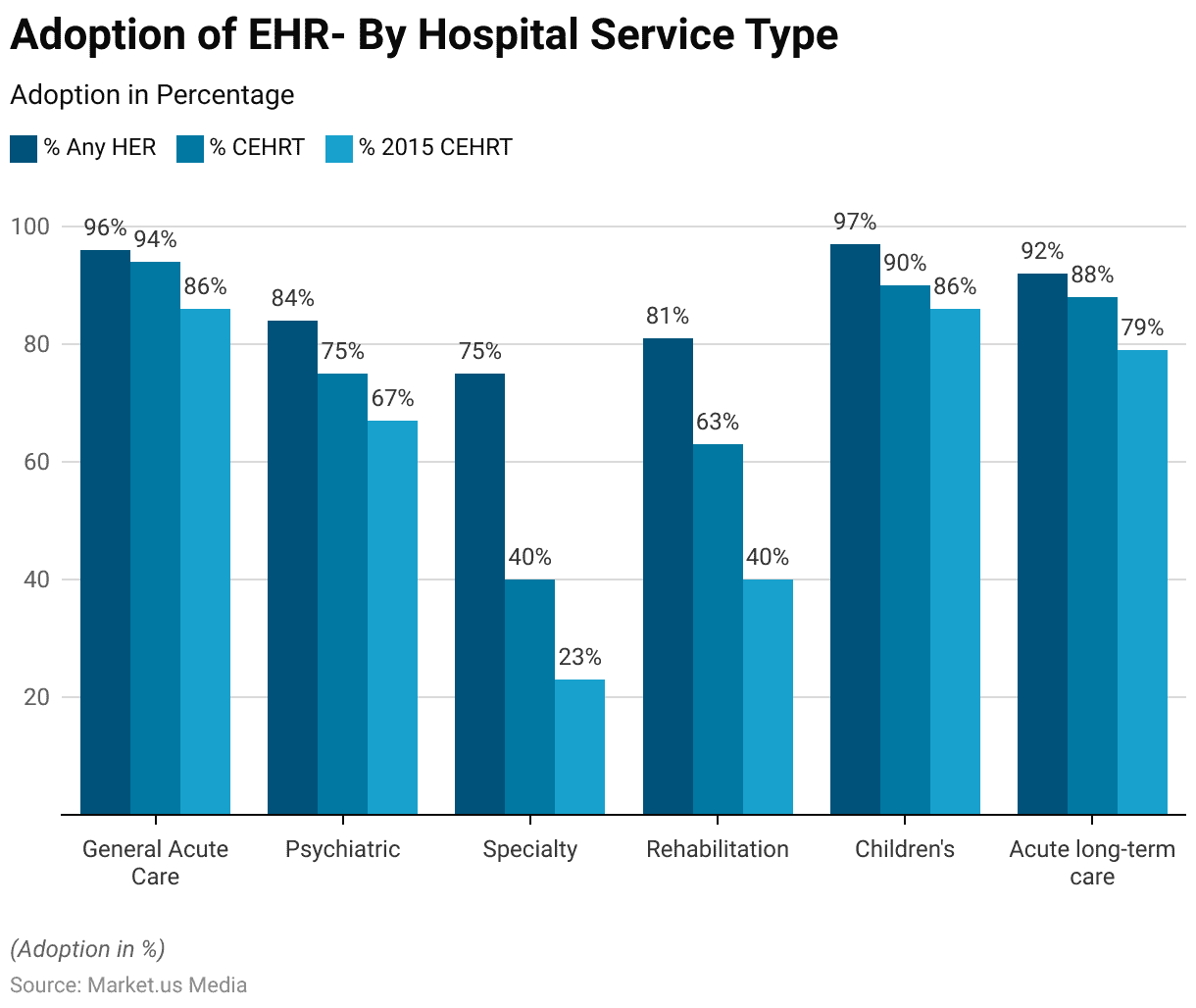
EHR Adoption by Primary Care Physicians – According to Country/Industry Statistics
- In 2019, the adoption of electronic medical records (EMRs) among primary care physician practices exhibited significant variation across different countries.
- The Netherlands and the United Kingdom led with a 99% adoption rate, followed closely by Sweden at 98% and Australia at 97%.
- The United States also demonstrated a high adoption rate, with 91% of primary care practices reporting the use of EMRs, aligning with the comparable country average of 91%.
- France and Germany each reported an 88% adoption rate, while Canada showed a slightly lower rate at 86%.
- Switzerland lagged, with only 70% of primary care physician practices utilizing EMRs.
- These figures highlight a strong trend towards the adoption of electronic medical records in primary care, particularly in European countries and Australia, while also indicating areas for potential growth in countries like Switzerland.
(Source: Peterson-KFF Health System Tracker)
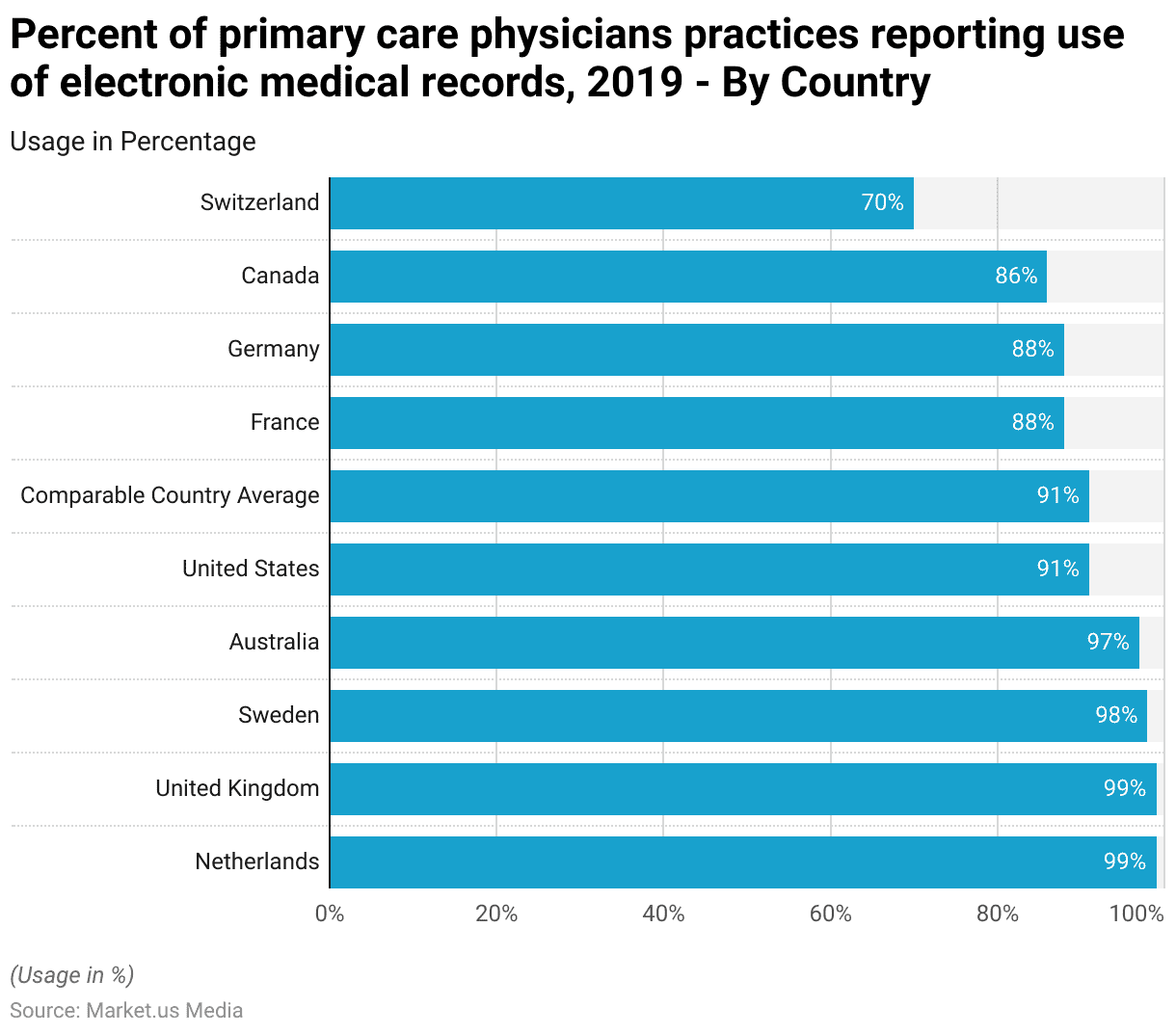
Adoption of EHR by Office-Based Physicians Industry Statistics
2004-2012
- The adoption of Electronic Health Records (EHR) by office-based physicians in the United States has shown a significant upward trend from 2004 to 2021.
- In 2004, only 20.8% of physicians had adopted any form of EHR, with no available data on basic or certified EHR systems.
- This percentage gradually increased, reaching 29.2% in 2006, when 10.5% of physicians were using basic EHR systems.
- By 2008, the adoption of any EHR had risen to 42%, with 16.9% using basic EHRs.
- The upward trend continued, and by 2010, 51% of physicians had adopted any EHR, with 27.9% using basic EHR systems.
- Significant growth occurred between 2011 and 2013, with adoption rates for any EHR reaching 57% and 71.8%, respectively. Basic EHR usage also increased, reaching 33.9% in 2011 and 39.6% in 2012.
2013-2021
- By 2013, 78.4% of physicians were using any EHR, with 48.1% utilizing basic systems.
- In 2014, 82.8% of physicians reported using any EHR, 50.5% used basic EHRs, and certified EHR adoption data became available, showing a 74% adoption rate.
- The trend continued upward, with 86.9% of physicians using any EHR and 53.9% using basic EHRs in 2015, while certified EHR adoption reached 77.9%.
- From 2016 onwards, data on basic EHR usage was not consistently available. But the adoption of certified EHRs remained high, with 77% in 2016, 79.7% in 2017, and 78.7% in 2018.
- Although there was a slight decline in the percentage of physicians using any EHR in 2019 (90%) and 2021 (88%). The adoption of certified EHR systems remained robust at 72% in 2019 and 78% in 2021.
- This data reflects a substantial increase in the adoption of EHR systems among office-based physicians over the years. With a marked shift towards certified EHR technologies.
(Source: The Office of the National Coordinator for Health Information Technology (ONC))

Adoption of EHR by Clinicians in European Nations Industry Statistics
- In 2020, the use of electronic health records (EHR) among clinicians varied significantly across selected European countries.
- The Netherlands reported the highest share of respondents using EHR, with 97%, followed by Denmark at 95%.
- Norway also demonstrated a high adoption rate of 89%, while the United Kingdom reported an 87% usage rate.
- Across Europe, the average share of clinicians using EHR was 81%.
- Germany had a lower adoption rate at 77%, followed by Portugal at 74% and Italy at 69%.
- These figures reflect a widespread but uneven adoption of EHR systems across Europe. With some countries achieving near-universal usage among clinicians and others still progressing toward broader implementation.
(Source: Statista)
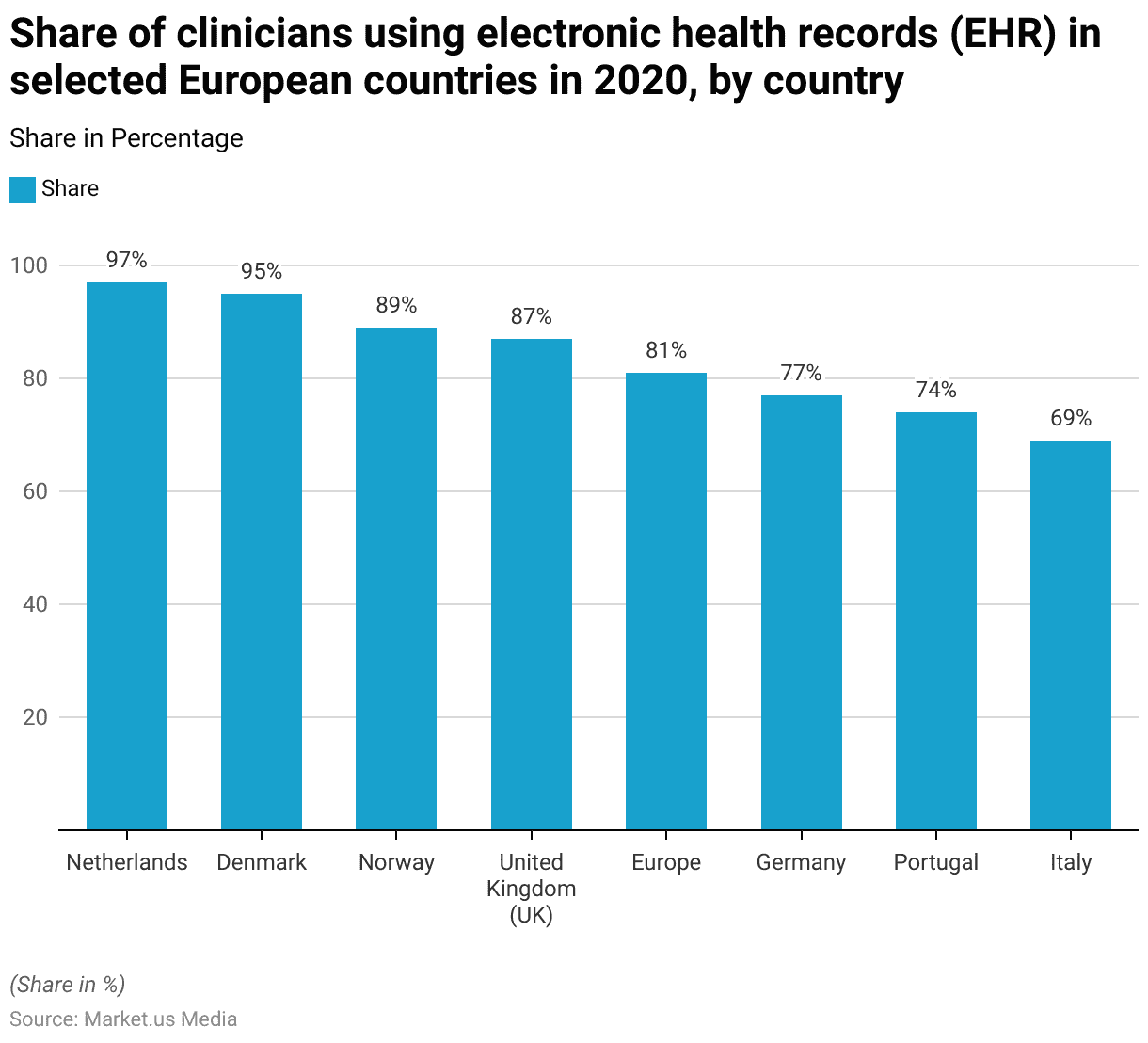
Office-based Physicians with EMR/EHR Systems Industry Statistics
2004-2012
- The adoption of Electronic Medical Records (EMR) and Electronic Health Records (EHR) systems among office-based physicians in the United States has seen significant growth from 2004 to 2021.
- In 2004, only 20.8% of physicians had adopted any form of EHR, with no available data on basic or certified systems.
- This figure rose to 23.9% in 2005 and continued to increase, reaching 29.2% in 2006 when 10.5% of physicians were using basic EHR systems.
- By 2007, 34.8% of physicians had adopted any EHR, with 11.8% using basic EHRs.
- In 2008, the adoption rate for any EHR rose to 42%, with 16.9% of physicians using basic systems.
- This upward trend continued, with 48.3% of physicians using any EHR and 21.8% using basic EHRs by 2009.
- The year 2010 saw 51% of physicians adopting any EHR, with 27.9% using basic systems.
- By 2011, these figures had increased to 57% for any EHR and 33.9% for basic EHRs.
- Significant growth was observed in 2012, with 71.8% of physicians using any EHR and 39.6% using basic systems.
2013-2021
- In 2013, 78.4% of physicians reported using any EHR, with 48.1% using basic systems.
- By 2014, the adoption rate for any EHR had reached 82.8%, with 50.5% using basic EHRs.
- Data on certified EHR systems became available in 2015, showing that 86.9% of physicians used any EHR, 53.9% used basic EHRs, and 77.9% used certified systems.
- In 2017, the adoption rate for any EHR was 85.9%, with 79.7% using certified systems.
- This trend continued, with 92.1% of physicians using any EHR in 2018 and 78.7% using certified systems.
- In 2019, the adoption rate for any EHR slightly declined to 89.9%, with 72.3% using certified systems.
- By 2021, 88.2% of physicians were using any EHR, with 77.8% using certified systems.
- This data highlights the substantial increase in EHR adoption among office-based physicians over the years, with a notable shift towards certified EHR technologies.
(Source: Statista)
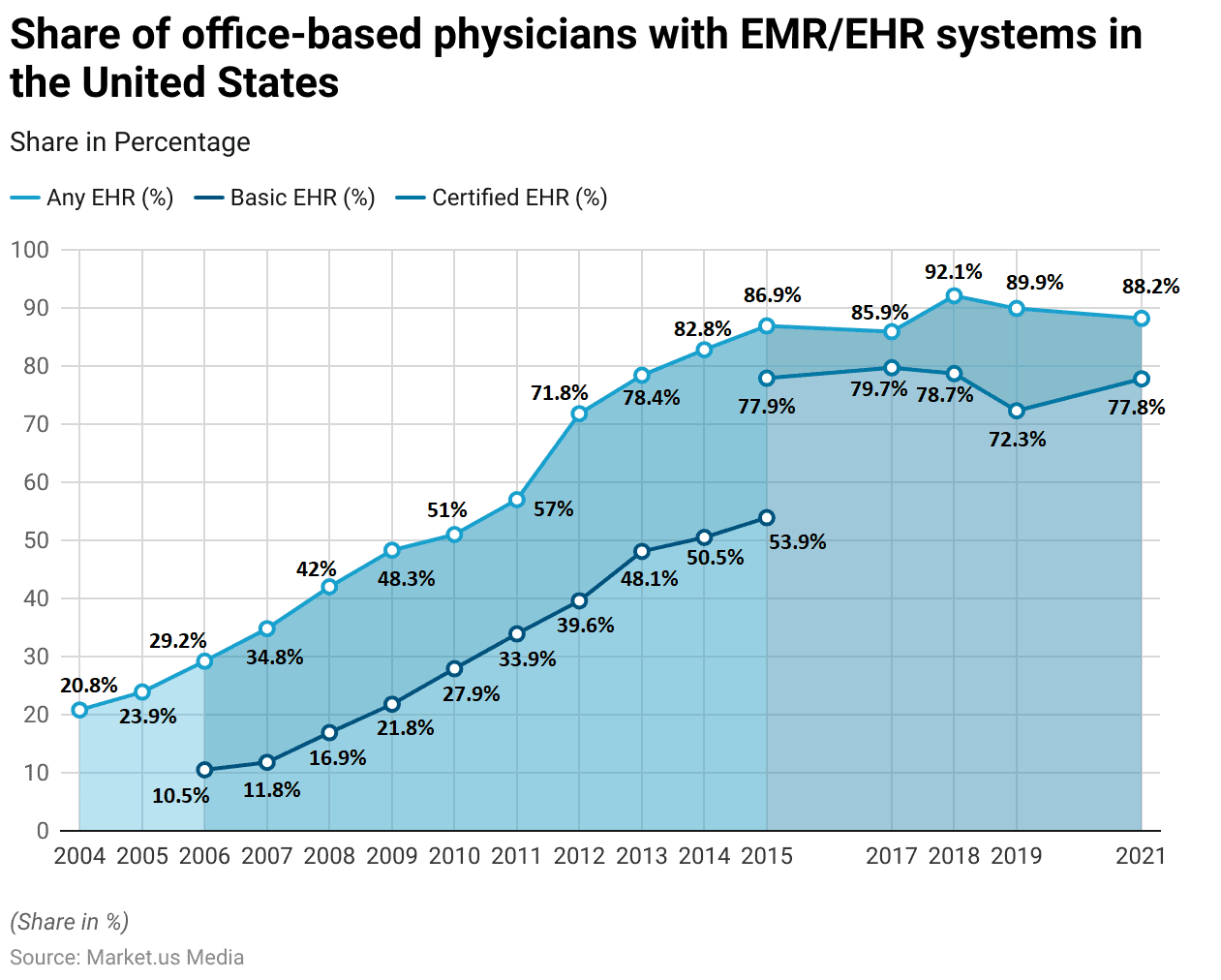
Identify Patients for Care With Physician EHR Capability Statistics
Physician EHR Capability to Identify Patients for Care – By Practice Industry Size Statistics
- In 2017, the percentage of office-based U.S. physicians who had computerized capability to identify patients due for preventive or follow-up care varied by practice size.
- Solo practices had the lowest adoption rate, with 53.1% of physicians having this capability.
- Practices with two physicians saw a significantly higher rate at 70.2%.
- For practices with three to five physicians, 66.8% of physicians had the necessary computerized capability.
- Larger practices, with six or more physicians, reported a 69.6% adoption rate.
- Overall, 64.7% of office-based physicians across all practice sizes could identify patients due for preventive or follow-up care through computerized systems, indicating a notable but varied adoption rate depending on the size of the practice.
(Source: Statista)
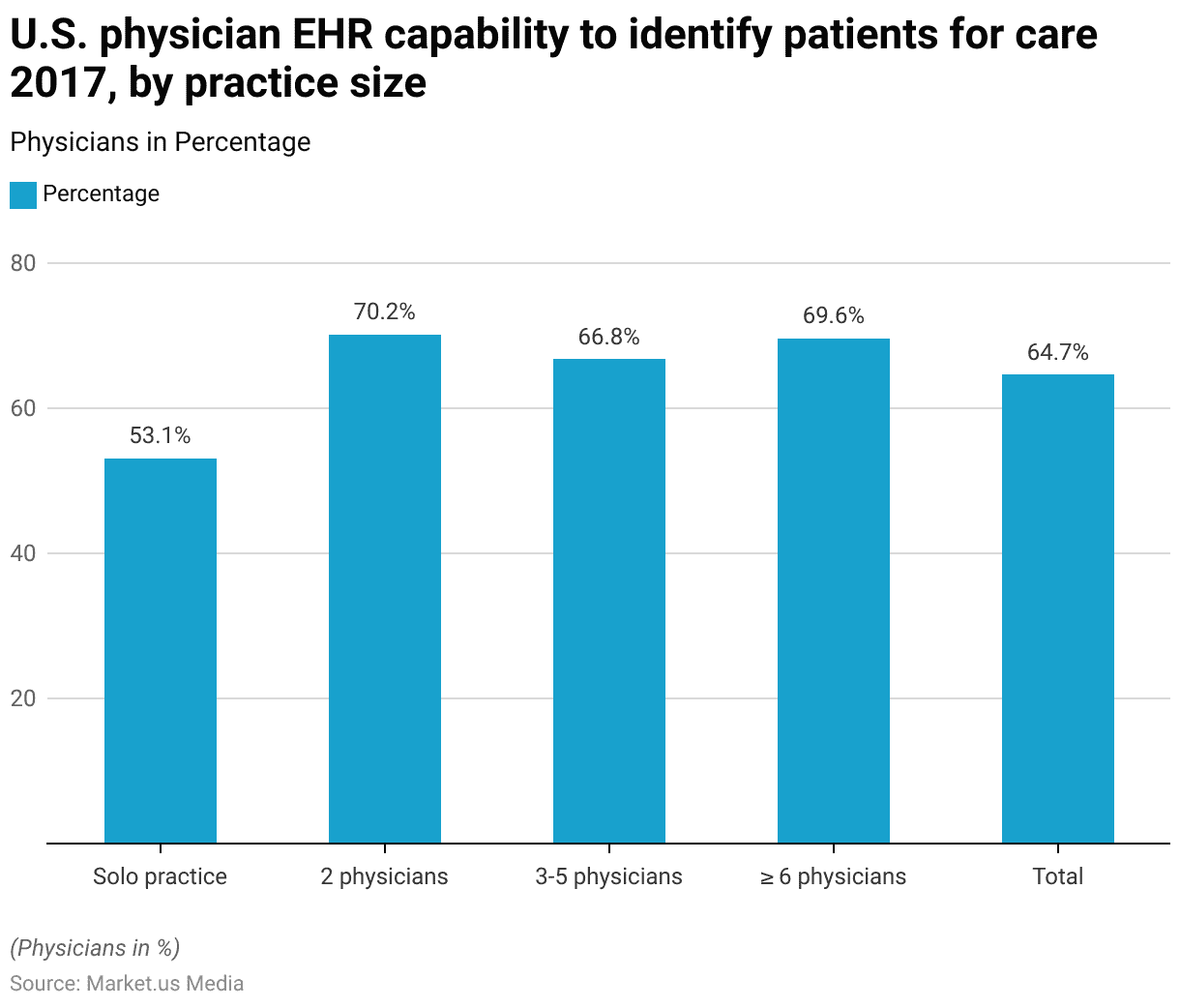
Physician EHR Capability to Identify Patients for Care – By Specialty Industry Statistics
- In 2017, the percentage of office-based U.S. physicians with the computerized capability to identify patients due for preventive or follow-up care varied across medical specialties.
- Primary care physicians had the highest adoption rate at 72.9%.
- In contrast, physicians in surgical care specialties reported a lower adoption rate of 54.8%.
- Non-primary care physicians had a computerized capability rate of 58.5%.
- Overall, 64.7% of office-based physicians across all specialties had the necessary computerized systems to identify patients needing preventive or follow-up care.
- This data underscores the disparity in adoption rates among different medical specialties, with primary care leading the way in utilizing computerized systems for patient care management.
(Source: Statista)
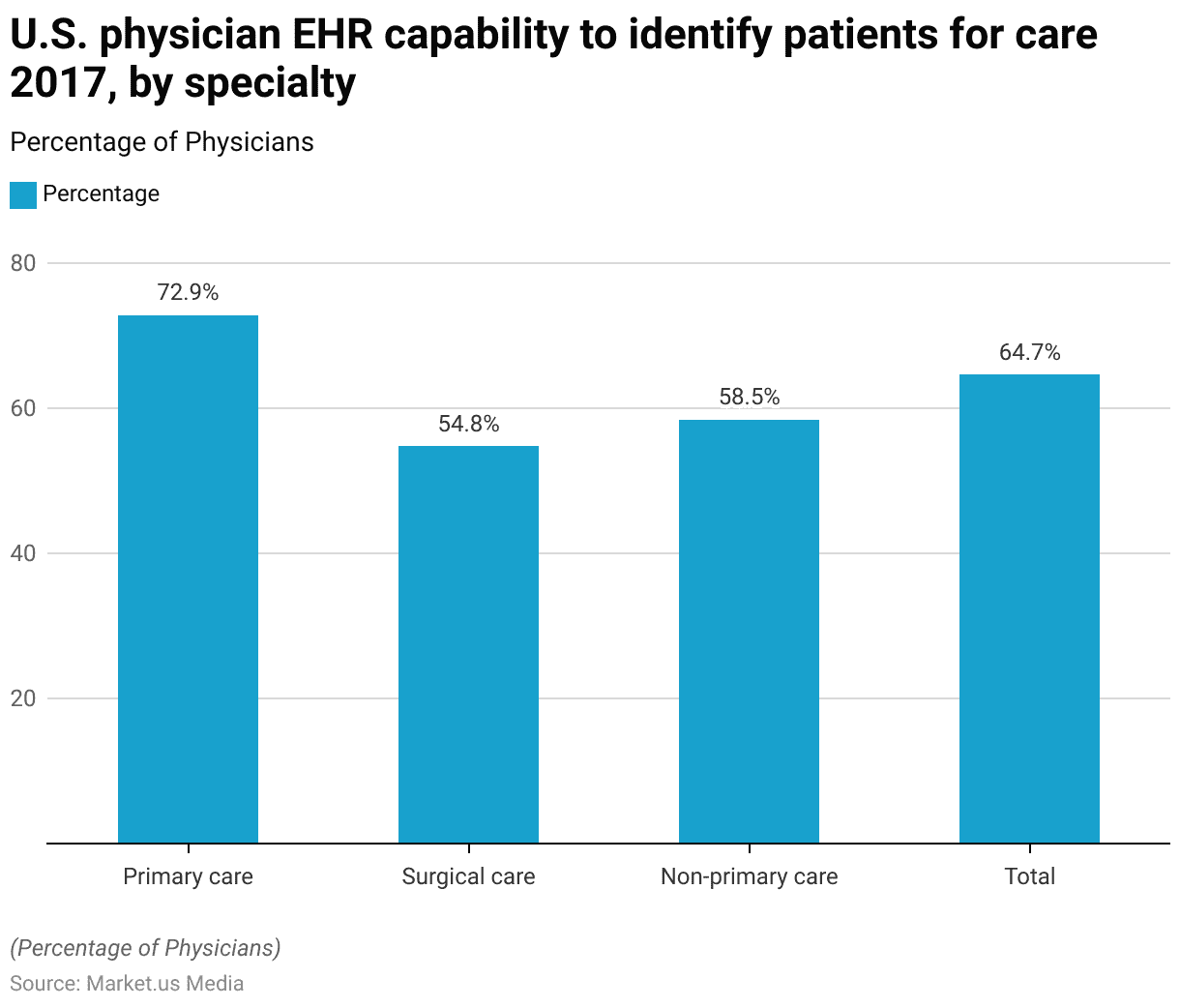
Impact of the EHR Industry on Patient Outcomes Statistics
- The implementation of Electronic Health Records (EHR) has significantly improved various patient outcomes.
- Access to critical information has seen the most substantial enhancement, with an 80% improvement, facilitating timely and informed decision-making in patient care.
- Preventive care adherence has increased by 30%, underscoring the role of EHR in promoting routine health maintenance and early intervention.
- Hospital readmissions have also decreased by 30%, indicating better patient monitoring and follow-up care.
- Chronic disease management has improved by 25%, reflecting more effective tracking and treatment of long-term conditions.
- Additionally, medication errors have been reduced by 48%, highlighting the EHR’s ability to enhance accuracy in prescribing and administering medications.
- These improvements collectively demonstrate the positive impact of EHR systems on the quality and efficiency of healthcare delivery.
(Source: Journal of General Internal Medicine, Health Affairs, The American Journal of Medicine)
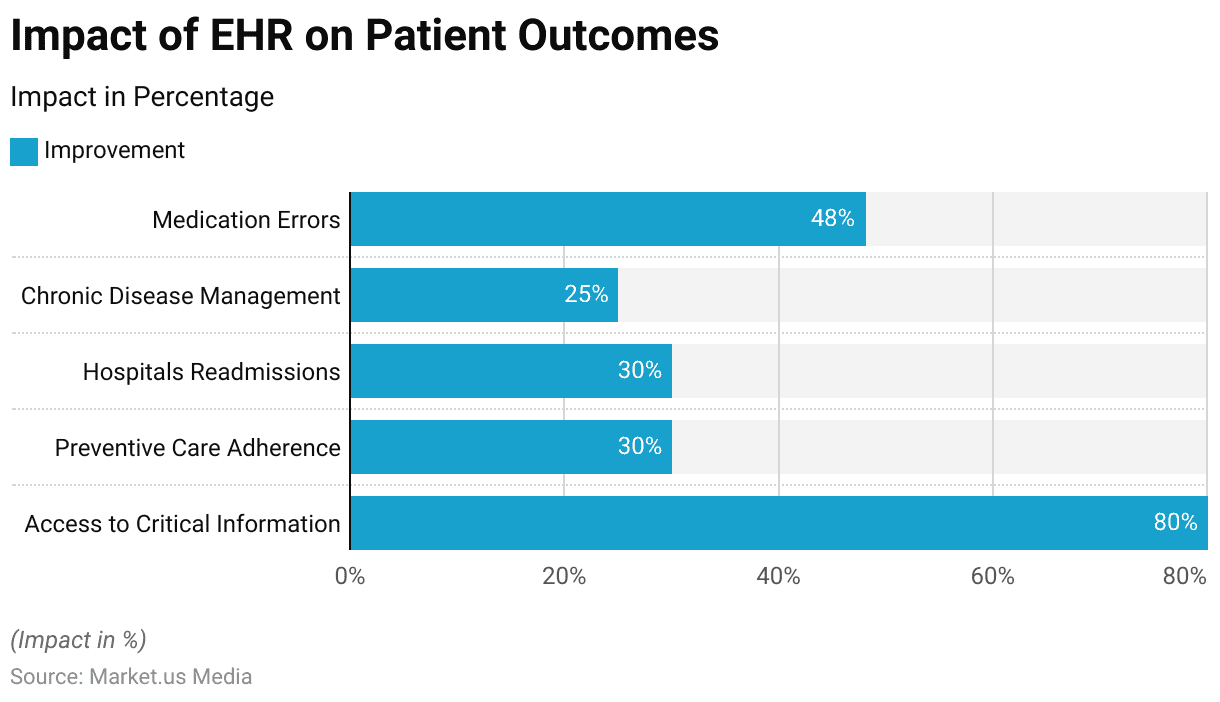
EHR Industry Statistics – By Region
Primary Care Physicians Using EMR – By Country
- As of 2019, the adoption of electronic medical records (EMR) among primary care physicians varied across selected countries, with New Zealand achieving full adoption at 100%.
- England, the Netherlands, and Norway each reported a 99% adoption rate, closely followed by Sweden at 98% and Australia at 97%.
- The United States showed a significant adoption rate of 91%, while France and Germany both reported 88%.
- Canada had an 86% adoption rate, and Switzerland lagged with 70% of primary care physicians using EMR systems.
- These figures highlight the widespread integration of EMR in primary care across many countries, with some achieving near-universal adoption while others, such as Switzerland, still have room for growth.
(Source: Statista)

United States
- Certified electronic health record (EHR) systems are implemented in more than 95% of non-federal acute care hospitals across the United States.
- Around 85% of office-based physicians utilize EHR technology in various capacities.
- Approximately 64% of U.S. hospitals exchange patient data electronically with external providers.
- The adoption rate of EHR systems among long-term care facilities stands at approximately 60%.
- Annually, the United States allocates over $3.5 billion towards EHR incentives through the Meaningful Use program.
(Sources: ONC Health IT Dashboard, CDC/NCHS National Ambulatory Medical Care Survey, National Center for Health Statistics, Health Affairs)
United Kingdom
- In 2020, the United Kingdom reported the highest technology adoption rate in healthcare. With 87% of clinicians frequently using electronic health records.
- E-prescribing has been adopted by 69% of UK medical professionals. While, 52% utilize online booking for appointments, reflecting a notable shift toward digital scheduling methods.
- Approximately 97% of general practitioner offices use EHR systems. EHRs are in place at over 80% of hospitals.
- The UK dedicates over £200 million each year to digital health initiatives, including the implementation of EHRs.
- Shared EHR systems among NHS hospitals have achieved a 60% adoption rate.
- In England, 79% of community pharmacies can access Summary Care Records.
(Source: NHS Digital)
Canada
- EHR adoption among hospitals in Canada exceeds 85%.
- Around 77% of physicians have electronic access to laboratory results.
- In community practices, EHR adoption rates have risen to 57%.
- Canada has invested more than CAD 2 billion in digital health projects, including initiatives focused on electronic health records.
- As of March 2021, Canada had approximately 500,000 potential EHR users among its healthcare professionals.
(Sources: Canadian Institute for Health Information, Canada Health Infoway, Statista)
Australia
- More than 90% of general practices in Australia now use electronic health record systems, and they are in place at over 85% of public hospitals across the country.
- About three-quarters of specialists also use these systems in their practices.
- Adoption of electronic health records in residential aged care facilities is approximately 45%.
- Australia has committed over AUD 2 billion to digital health initiatives, including investments in the My Health Record program.
(Source: Australian Digital Health Agency)
Germany
- Roughly 80% of general practitioners in Germany utilize EHR systems.
- EHR adoption among German hospitals stands at about 70%.
- Approximately 53% of healthcare providers exchange patient data electronically.
- Electronic medication management systems are accessible to 39% of German physicians.
- The German government has invested more than €1.2 billion in advancing digital health initiatives, including the adoption of EHRs.
EHR Industry Interoperability and Health Information Exchange Statistics
- In 2021, just 46% of U.S. hospitals had adopted basic EHR interoperability, highlighting significant room for improvement.
- This shortfall in interoperability reportedly costs the healthcare system around $30 billion annually due to inefficiencies and redundant testing.
- A survey of healthcare providers revealed that 53% face challenges with EHR interoperability, hindering seamless patient information exchange.
- Moreover, these gaps contribute to patient safety issues, with inadequate health information exchange being cited in 20% of adverse events.
- However, Health Information Exchanges (HIEs) have shown growth, with 96% of hospitals participating in an HIE network by 2021.
- Despite this, only 20% of HIEs have achieved full interoperability, allowing seamless data exchange with other HIEs and EHR systems.
- Among healthcare providers using HIEs, 88% noted improvements in care coordination and enhanced patient outcomes.
- Patient access to electronic health data through HIEs also increased, with 62% of U.S. individuals having such access in 2021.
(Sources: Health Affairs, The Joint Commission, ONC Data Brief)
The EHR Industry Benefits
- The clinical benefits reported by Electronic Health Record (EHR) users indicate significant improvements in patient care and medical practice efficiency.
- Among all physicians using EHRs, 78% reported overall enhanced patient care, with this figure rising to 85% for those with Meaningful Use (MU)-certified EHR systems and at least two years of EHR experience.
- However, Remote access to patient charts was reported by 81% of all EHR users, increasing to 87% among experienced users with MU-certified systems.
- Alerts for potential medication errors were noted by 65% of all EHR users, compared to 70% for the more experienced group.
- Similarly, alerts for critical lab values were reported by 62% of all users, with a higher rate of 70% among those with certified systems and extended experience.
- Reminders to provide preventive care were experienced by 47% of all EHR users, rising to 55% for those with MU-certified systems.
- Lastly, reminders to provide guideline-compliant care for chronically ill patients were reported by 45% of all users, compared to 54% among those with more experience and certified EHR systems.
- However, These benefits underscore the value of EHR systems, particularly those that are MU-certified and used over a longer period.
(Source: Medscape)
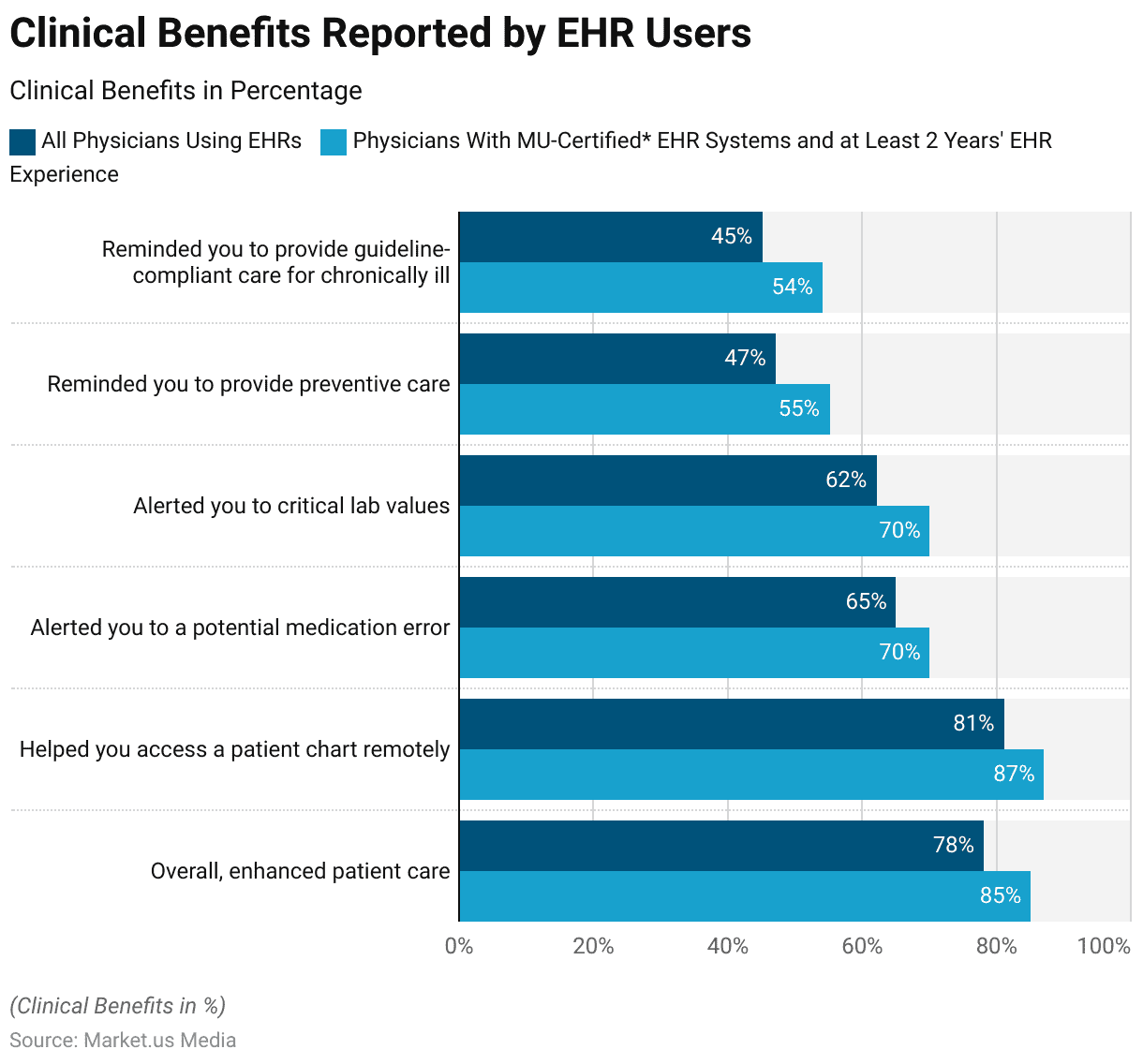
Challenges in the EHR Industry Statistics
- The implementation of Electronic Health Records (EHR) in India faces several significant challenges.
- Security and privacy concerns are paramount, affecting 28% of the implementation efforts, and are closely tied to the issue of lack of interoperability, which also impacts 28% of the initiatives.
- Moreover, the digital divide, reflecting the disparity in technology access and literacy among different populations, poses a challenge for 19% of the EHR implementation efforts.
- Business continuity concerns, which involve maintaining consistent and reliable operations during and after the transition to EHR, affect 13% of the efforts.
- Additionally, only 3% of the challenges are attributed to the cost efficiency of implementing EHR systems.
- These obstacles highlight the multifaceted difficulties India faces in adopting EHR technologies, necessitating comprehensive strategies to address security, interoperability, digital access, and operational continuity.
(Source: Appknox)

Regulations for EHR Industry Statistics
- Regulations for Electronic Health Records (EHR) vary significantly by country, reflecting diverse approaches to healthcare data management and patient privacy.
- In the United States, the Health Information Technology for Economic and Clinical Health (HITECH) Act, part of the American Recovery and Reinvestment Act, sets the framework for EHR adoption, emphasizing interoperability and meaningful use of certified EHR technology.
- The 21st Century Cures Act further enhances these regulations by mandating patient access to their health information and prohibiting information blocking, ensuring seamless data sharing across healthcare providers.
- In Europe, the General Data Protection Regulation (GDPR) governs the use of EHRs, focusing on data protection and privacy.
- Countries like the Netherlands and the UK have near-universal EHR adoption among primary care physicians, supported by national health services that standardize EHR implementation.
- Meanwhile, in India, challenges such as security concerns, lack of interoperability, and the digital divide hinder widespread EHR adoption.
- These regulations and challenges highlight the complexity of achieving effective EHR implementation worldwide, requiring tailored strategies to meet specific national requirements and healthcare infrastructures.
(Sources: Office of the National Coordinator for Health Information Technology (ONC), NextTech, American Medical Association (AMA))
Recent Developments
Acquisitions and Mergers:
- Cerner acquires Kantar Health: In mid-2023, Cerner Corporation completed its $375 million acquisition of Kantar Health, a global leader in health information, analytics, and research. This acquisition aims to enhance Cerner’s data analytics capabilities and provide more comprehensive healthcare insights.
- Allscripts acquires CarePort Health: Allscripts completed its acquisition of CarePort Health for $250 million in late 2023. This merger is expected to strengthen Allscripts’ care coordination capabilities and improve patient outcomes by integrating CarePort’s post-acute care management solutions with Allscripts’ EHR systems.
New Product Launches:
- Epic Systems’ Cosmos: In early 2024, Epic Systems launched Cosmos, a new data-driven platform that leverages EHR data to provide real-time insights for clinicians. Cosmos aims to improve patient care by facilitating data sharing and research across healthcare organizations.
- Cerner’s Seamless Exchange: Cerner introduced Seamless Exchange in late 2023, a feature that enhances interoperability by enabling healthcare providers to share patient information more efficiently across different EHR systems, ensuring better continuity of care.
Funding:
- Elation Health raises $40 million: Elation Health, an EHR provider focused on primary care, secured $40 million in a funding round in 2023. This funding will be used to expand its platform capabilities and support primary care practices in delivering high-quality patient care.
- Kareo secures $50 million: In early 2024, Kareo, a cloud-based EHR and practice management platform, raised $50 million to enhance its software offerings and expand its market reach among small to mid-sized healthcare practices.
Technological Advancements:
- AI Integration in EHRs: Advances in artificial intelligence are being integrated into EHR systems to improve clinical decision support, automate administrative tasks, and enhance patient data analysis, leading to more efficient and accurate healthcare delivery.
- Blockchain for Data Security: Blockchain technology is being explored for securing patient data in EHR systems, ensuring data integrity, enhancing security, and enabling transparent data sharing among authorized healthcare providers.
Market Dynamics:
- Growth in EHR Market: The global EHR market is projected to grow at a CAGR of 6.8% from 2023 to 2028, driven by the increasing adoption of digital health solutions. Government initiatives to promote EHR usage, and the need for efficient healthcare management.
- Rise in Telehealth Integration: The integration of telehealth capabilities into EHR systems is rising. Enabling healthcare providers to offer remote consultations and manage patient records more effectively, is particularly crucial in the post-pandemic era.
Regulatory and Strategic Developments:
- 21st Century Cures Act Final Rule: The US Department of Health and Human Services (HHS) implemented the 21st Century Cures Act Final Rule in 2023. Promoting interoperability and prohibiting information blocking to ensure seamless data exchange across EHR systems.
- EU General Data Protection Regulation (GDPR): Compliance with GDPR continues to be a priority for EHR providers operating in Europe. Ensuring that patient data is handled securely and transparently, and fostering trust in digital health solutions.
Research and Development:
- Patient-Centered EHRs: R&D efforts are focusing on developing patient-centered EHR systems that offer personalized health insights, improve patient engagement, and facilitate self-management of chronic conditions.
- Interoperability Standards: Researchers are working on establishing and refining interoperability standards to enable seamless data exchange between different EHR systems, enhancing collaborative care and improving patient outcomes.
Conclusion
EHR Industry Statistics: The Electronic Health Records (EHR) industry has made substantial progress, driven by regulatory mandates and technological advancements. Significantly, improving patient care and healthcare efficiency.
Key regulations such as the HITECH Act and the 21st Century Cures Act in the U.S. have promoted widespread adoption, interoperability, and patient access to health information.
Countries like the Netherlands and the UK lead in adoption rates, while challenges such as data privacy. Interoperability and the digital divide persist, especially in developing nations like India.
Future growth in the EHR industry hinges on overcoming these challenges through enhanced regulatory support and technological innovation.
FAQs
An Electronic Health Record (EHR) is a digital version of a patient’s paper chart. EHRs are real-time, patient-centered records that make information available instantly and securely to authorized users. They contain a patient’s medical history, diagnoses, medications, treatment plans, immunization dates, allergies, radiology images, and laboratory and test results.
EHRs improve patient care by providing accurate, up-to-date, and complete information about patients at the point of care. They enable quick access to patient records for more coordinated and efficient care. Support better clinical decision-making, and help reduce medical errors.
In the United States, the Health Information Technology for Economic and Clinical Health (HITECH) Act and the 21st Century Cures Act are key regulations that govern the use of EHRs. The HITECH Act promotes the adoption and meaningful use of EHRs. While the 21st Century Cures Act enhances patient access to their health information and prohibits information blocking. The Health Insurance Portability and Accountability Act (HIPAA) also sets standards for the privacy and security of electronic health information.
Challenges in EHR implementation include high initial costs, ongoing maintenance expenses, and the need for significant changes in workflow. Additionally, there are concerns about data privacy and security, interoperability issues among different EHR systems, and the digital divide affecting access to technology.
EHRs enhance interoperability by allowing different healthcare providers and systems to share and access patient information seamlessly. Standards such as the Fast Healthcare Interoperability Resources (FHIR) and the use of Application Programming Interfaces (APIs) are critical for achieving interoperability.
Discuss your needs with our analyst
Please share your requirements with more details so our analyst can check if they can solve your problem(s)



